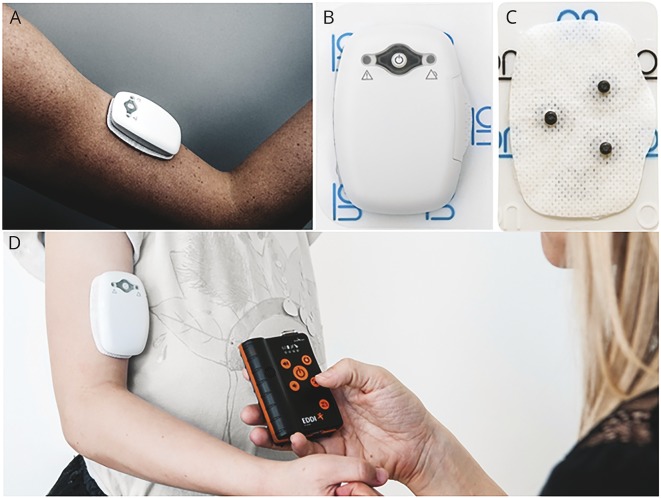Next in clinical practice: Automated real-time detection of seizures via wearable EMG devices

(A) The wearable device placed on the brachial biceps muscles. (B, C) The wearable device, which is connected to the self-adhesive patch, containing the recording electrodes and the ground electrode. (D) Remote control of the device. (Epileptic seizure Detector Developed by IctalCare). Credit: Neurology.
___
Wearable EMG Found to Detect Seizures (Neurology Today):
“A new study demonstrates the feasibility of using a wearable electromyography device to detect tonic-clonic seizures…The Neurology paper was among the first to demonstrate its results prospectively, using a pre-specified cut-off for determining that a GTCS is occurring. And at nine seconds, its latency in doing so (from the time of onset as measured by an independent observer) is also among the fastest described so far, the study authors and independent experts noted…
The new paper comes on the heels of two other studies on wearable EMG for seizure detection…Altogether, they demonstrate the growing feasibility of incorporating wearable seizure-detection devices into clinical practice — both to quantify for physicians how well patients are responding to medication, and to help caregivers respond quickly to ongoing seizures.
With a sensitivity of 93.8 percent, the device detected 30 of 32 GTCS over a total recording time of 3,735.5 hours. The rate of false alarms was 0.67 per day, but two-thirds of the patients had no false alarms. For 24 of 71 patients (34 percent) who did experience a false alarm, the most common reason was due to physical exercise, which accounted for 68 percent of all false alarms. Only two false alarms occurred during sleep.
Dr. Beniczky said the overall rate of 0.67 false alarms per day “still needs to be improved. It’s not such a problem for patients, because it happens almost entirely during the day, so they can stop the alarm when it happens. But it is not good enough if we want a truly automatic device.”
The Study
Automated real-time detection of tonic-clonic seizures using a wearable EMG device (Neurology). From the abstract:
- OBJECTIVE: To determine the accuracy of automated detection of generalized tonic-clonic seizures (GTCS) using a wearable surface EMG device.
- METHODS: We prospectively tested the technical performance and diagnostic accuracy of real-time seizure detection using a wearable surface EMG device. The seizure detection algorithm and the cutoff values were prespecified. A total of 71 patients, referred to long-term video-EEG monitoring, on suspicion of GTCS, were recruited in 3 centers. Seizure detection was real-time and fully automated. The reference standard was the evaluation of video-EEG recordings by trained experts, who were blinded to data from the device. Reading the seizure logs from the device was done blinded to all other data.
- RESULTS: The mean recording time per patient was 53.18 hours. Total recording time was 3735.5 hours, and device deficiency time was 193 hours (4.9% of the total time the device was turned on). No adverse events occurred. The sensitivity of the wearable device was 93.8% (30 out of 32 GTCS were detected). Median seizure detection latency was 9 seconds (range ‑4 to 48 seconds). False alarm rate was 0.67/d.
- CONCLUSIONS: The performance of the wearable EMG device fulfilled the requirements of patients: it detected GTCS with a sensitivity exceeding 90% and detection latency within 30 seconds.
- CLASSIFICATION OF EVIDENCE: This study provides Class II evidence that for people with a history of GTCS, a wearable EMG device accurately detects GTCS (sensitivity 93.8%, false alarm rate 0.67/d).


